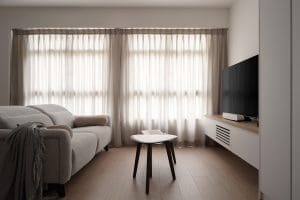Table of Contents
Toggle
The Essence of Minimalism
In the world of interior design, minimalism has gained tremendous popularity for its ability to create serene and elegant spaces. The essence of minimalist interior design lies in its focus on simplicity, clean lines, and clutter-free spaces. By embracing the principles of minimalism, homeowners can achieve a harmonious and calming environment that exudes a sense of tranquility. At the heart of minimalist interior design is the concept of simplicity. Minimalist spaces are characterized by a thoughtful and deliberate curation of objects, where every item serves a purpose and contributes to the overall aesthetic. By embracing simplicity, homeowners can create a sense of calm and order in their living spaces, free from unnecessary distractions and visual clutter. Clean aesthetics play a crucial role in minimalist interior design. This design approach emphasizes the use of neutral color palettes, such as whites, grays, and earth tones, to create a cohesive and balanced look. These colors help to create a sense of spaciousness and serenity, allowing the focus to be on the clean lines and forms of the furniture and architectural elements.Key Elements of Minimalist Interior Design:
- Simple Home Decor: Minimalist interior design embraces understated and timeless decor elements. The use of natural materials, such as wood and stone, adds warmth and texture to the space.
- Decluttered Spaces: Minimalism promotes a clutter-free environment where every item has its place. By adopting smart storage solutions and eliminating unnecessary items, homeowners can create a sense of order and tranquility.
- Functional Furnishings: The furniture in minimalist spaces is characterized by clean lines and a focus on functionality. Multi-functional pieces and minimalist furniture designs are favored to optimize space and avoid excessive ornamentation.
- Natural Light: Minimalist interior design often prioritizes natural light, as it helps to create an airy and open atmosphere. Large windows, skylights, and light-colored walls contribute to the overall brightness of the space.
- Minimalist Art and Decor: In keeping with the minimalist aesthetic, artwork and decor items are carefully selected to enhance the space without overpowering it. Simple and abstract art pieces, as well as tasteful decorative accents, can add interest to the room while maintaining a clean and cohesive look.
Portfolio
Elements of Minimalist Interior Design
Minimalist interior design revolves around the fundamental principle of simplicity. By incorporating minimalist furniture with clean lines, and drawing inspiration from Scandinavian and contemporary design, you can create a space that exudes elegance and tranquility.The Power of Minimalist Furniture
Minimalist furniture forms the backbone of any minimalist interior. With their sleek and streamlined designs, these furniture pieces enhance the sense of spaciousness and serenity in a room. Think along the lines of minimalistic sofas, chairs, and tables in neutral shades, allowing them to blend seamlessly with the overall design scheme.Influence of Scandinavian Design
Scandinavian design is known for its focus on functionality, simplicity, and natural elements. Incorporating Scandinavian design elements in minimalist interiors often involves using light-colored woods, such as birch or pine, and incorporating organic shapes. This fusion creates a warm and inviting atmosphere, promoting a sense of coziness and comfort.Contemporary Design: A Modern Minimalist Twist
Contemporary design infuses a modern touch into minimalist interiors. It involves incorporating sleek materials, such as glass and metal, and experimenting with unconventional shapes and forms. By embracing contemporary design, you can introduce a unique and dynamic element to your minimalist space, creating a perfect blend of simplicity and modernity. Incorporating minimalist furniture alongside the influence of Scandinavian and contemporary design elements will help you create a truly remarkable minimalist interior. The clean lines, understated aesthetics, and seamless blend of functionality and style will elevate your space to new heights of elegance and sophistication.Creating a Minimalist Living Room
When it comes to designing your living room, embracing a minimalist approach can create a serene and elegant space. A minimalist living room is all about simplicity and refined aesthetics, allowing you to focus on the essentials while maintaining a contemporary design.Decluttering for a Calm Ambiance
Achieving a minimalist living room starts with decluttering. Remove any unnecessary items, leaving only the essential pieces that contribute to a clean and organized space. By eliminating clutter, you create a sense of calm and openness that is characteristic of minimalist design.Choosing the Right Furniture
When selecting furniture for your minimalist living room, opt for sleek and streamlined pieces. Clean lines and simple designs are key in achieving a minimalist aesthetic. Consider investing in furniture made from natural materials such as wood or leather to add warmth and texture to the space.Incorporating Contemporary Design Elements
To enhance the minimalist look of your living room, incorporate contemporary design elements. Add pops of color through artwork or subtle accents, but keep the overall color palette neutral for a clean and uncluttered space. Embrace natural light by using sheer curtains or opting for open windows, further enhancing the minimalist feel.- Choose a neutral color palette
- Use sheer curtains and maximize natural light
- Add pops of color through artwork or subtle accents
Designing a Minimalist Bedroom
When it comes to creating a serene and relaxing bedroom, minimalist decor is the perfect choice. Embracing simplicity and clean lines, minimalist bedroom decor brings a sense of calm and tranquility to your personal space. By following a few key principles, you can transform your bedroom into a minimalist haven that promotes rest and rejuvenation.1. Neutral Color Palettes
Avoiding bold and busy colors is essential in minimalist bedroom design. Opt for neutral color palettes, such as whites, grays, and earth tones. These calming hues create a clean and uncluttered ambiance, allowing you to fully unwind after a long day.2. Simple Bedding
Choose bedding that aligns with the minimalist aesthetic. Opt for crisp white linens or muted tones for a clean and understated look. Keep embellishments and patterns to a minimum, focusing on simplicity and comfort.3. Minimalist Storage Solutions
Clutter is the enemy of a minimalist bedroom. Look for storage solutions that are sleek and discreet, such as built-in wardrobes or hidden under-bed storage. Keep surfaces clear and only display a few carefully chosen decorative items to maintain a sense of tranquility.4. Subtle Lighting
Lighting plays a crucial role in setting the ambiance of a minimalist bedroom. Opt for soft and diffused lighting options, such as pendant lights or wall sconces, to create a soothing atmosphere. Avoid harsh or overly bright lights that can disrupt the calmness of the space.5. Mindful Decorations
When it comes to decorations, less is more in a minimalist bedroom. Choose a few carefully curated pieces that bring joy and serenity to your space. Consider incorporating natural elements, such as plants or a small vase with fresh flowers, to add a touch of life and tranquility. By implementing these minimalist bedroom decor ideas, you can create a peaceful sanctuary that promotes relaxation and rejuvenation. Embrace simplicity, declutter your space, and allow the clean aesthetics of minimalist design to transform your bedroom into a serene oasis.Transforming Other Spaces with Minimalism
In addition to the living room and bedroom, minimalist interior design can be successfully applied to other spaces in your home, such as the kitchen, bathroom, and home office. By incorporating the principles of minimalism and contemporary design, you can transform these areas into havens of simplicity and tranquility.Kitchen
The kitchen is often the heart of the home, and a minimalist approach can create a clean and functional space. Opt for sleek and streamlined cabinetry with hidden storage solutions to minimize visual clutter. Choose a neutral color palette, such as whites and greys, to create a sense of harmony. Keep countertops clear of unnecessary items and only display essential cookware and utensils. A clutter-free kitchen not only looks visually appealing but also provides a calming environment for meal preparation and cooking.Bathroom
A minimalist bathroom exudes a sense of relaxation and serenity. Choose simple and clean-lined fixtures and fittings to create a cohesive and sleek look. A monochromatic color palette, with shades of white or beige, can help create an airy and spacious feel. Keep toiletries and personal items neatly organized in storage baskets or sleek wall-mounted shelves, allowing for easy access while maintaining a clutter-free space. Minimalist bathroom design promotes a sense of tranquility and indulgence, perfect for unwinding after a long day.Home Office
Working from home can be a productive and enjoyable experience in a minimalist home office. Opt for a clean and uncluttered workspace by choosing a minimalist desk with plenty of storage drawers and compartments to keep your essentials organized. Use wire management solutions to keep cables neat and out of sight. Choose a comfortable yet simple chair that complements the overall aesthetic. Keep decor and accessories to a minimum, focusing on creating a calm and focused atmosphere that enhances productivity. By embracing minimalist interior design principles and incorporating contemporary design elements, you can create a cohesive and harmonious look throughout your entire home. The transformation of these spaces into minimalist havens will not only enhance the visual appeal but also provide an environment that promotes peace, tranquility, and productivity.Balancing Minimalism and Functionality
When it comes to minimalist interior design, finding the perfect balance between aesthetics and functionality is key. Striking this balance allows you to create spaces that not only look clean and elegant but also serve their purpose effectively. Here are some strategies to help you achieve this delicate equilibrium:1. Optimize Storage
In a minimalist design, storage solutions play a crucial role in keeping the space clutter-free. Consider incorporating clever storage options such as hidden cabinets, built-in shelves, or multifunctional furniture with hidden compartments to maximize storage while maintaining a minimalist aesthetic.2. Embrace Multifunctionality
When selecting furniture pieces, prioritize those that serve multiple purposes. For example, a sleek and minimalistic sofa with hidden storage or a coffee table that doubles as a desk. By integrating furniture that serves dual purposes, you can reduce the number of items in your space while still meeting your functional needs.3. Maintain a Clutter-Free Environment
One of the guiding principles of minimalist interior design is to eliminate unnecessary clutter. Adopting organizing systems and habits can help you maintain a clutter-free environment. Utilize minimalist storage solutions, such as decorative baskets or wall hooks, to keep frequently used items easily accessible yet out of sight.4. Focus on Essentials
When designing your minimalist space, keep your focus on essential items. Avoid unnecessary decorations or excessive furniture that may clutter the space. Instead, choose a few well-curated pieces that contribute to the overall design and functionality of the room.5. Embrace Natural Light
Maximize the use of natural light in your minimalist space to create a sense of openness and serenity. Opt for sheer curtains or blinds that allow light to filter through while maintaining privacy. Light-colored walls and reflective surfaces can also help bounce natural light, making the space feel more spacious and inviting. By implementing these strategies, you can achieve a perfect balance between minimalist interior design and functionality. Remember, a minimalist space should not only look beautiful but also enhance the functionality of your daily life.
How Can Ovon-D Interior Help You
If you want your home to be just as beautiful, then look no further. Book an online consultation with Ovon-D Interior today. Have some comments or suggestions you’d like to share with us?
Accreditation










Conclusion
Throughout this guide, we have explored the beauty and elegance of minimalist interior design for Singaporean homes. The concept of modern minimalism has proven to be a powerful tool for creating serene and stylish living spaces. By embracing simple home decor and clean aesthetics, homeowners can achieve a clutter-free and harmonious environment. From the living room to the bedroom, every area of the house can be transformed into a minimalist haven. It is important to balance minimalism with functionality, optimizing storage and incorporating multi-purpose furniture to create practical yet minimalist spaces. The key elements of minimalist interior design, such as minimalist furniture and contemporary design influences, can be seamlessly integrated to achieve a cohesive and modern look. With the knowledge gained from this guide, we hope you feel inspired and confident to embark on your own minimalist interior design journey. Embrace the essence of minimalism, transform your home into a serene oasis, and enjoy the benefits of a minimalist lifestyle.
Facebook
Twitter
LinkedIn
















